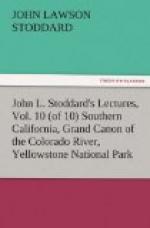[Illustration: AN INDIAN CHIEF.]
The region of the Yellowstone was to most Indian tribes a place of horror. They trembled at the awful sights they here beheld. But the obsidian cliff was precious to them all. Its substance was as hard as flint, and hence well suited for their arrow-heads. This mountain of volcanic glass was, therefore, the great Indian armory; and as such it was neutral ground. Hither all hostile tribes might come for implements of war and then depart unharmed. While they were here a sacred, inter-tribal oath protected them. An hour later, those very warriors might meet in deadly combat, and turn against each other’s breasts the weapons taken from that laboratory of an unknown power.
[Illustration: A TRAPPER.]
Can we wonder that, in former times, when all this region was still unexplored, and its majestic streams rolled nameless through a trackless wilderness, the statements of the few brave men who ventured into this enclosure were disbelieved by all who heard them? One old trapper became so angry when his stories of the place were doubted, that he deliberately revenged himself by inventing tales of which Muenchhausen would have been proud. Thus, he declared, that one day when he was hunting here he saw a bear. He fired at it, but without result. The animal did not even notice him. He fired again, yet the big bear kept on grazing. The hunter in astonishment then ran forward, but suddenly dashed against a solid mountain made of glass. Through that, he said, he had been looking at the animal. Unspeakably amazed, he finally walked around the mountain, and was just taking aim again, when he discovered that the glass had acted like a telescope, and that the bear was twenty-five miles away! Not far from the volcanic cliff which gave the trapper inspiration for his story, we reached one of the most famous basins of the Park. In briefest terms, these basins are the spots in the arena where the crust is thinnest. They are the trap-doors in a volcanic stage through which the fiery actors in the tragedy of Nature, which is here enacted, come upon the scene. Literally, they are the vents through which the steam and boiling water can escape. In doing so, however, the water, as at the Mammoth Springs, leaves a sediment of pure white lime or silica. Hence, from a distance, these basins look like desolate expanses of white sand. Beside them always flows a river which carries off the boiling water to the outer world.
[Illustration: THE NORRIS BASIN.]
[Illustration: A PLACE OF DANGER.]
No illustration can do justice to what is called the Norris Basin, but it is horrible enough to test the strongest nerves. Having full confidence in our guide (the Park photographer) we ventured with him, outside the usual track of tourists, and went where all the money of the Rothschilds would not have tempted us to go alone. The crust beneath our feet was hot, and often quivered as we walked. A single




